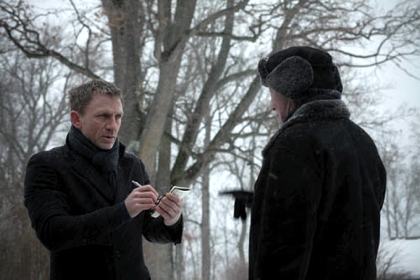Review
The Girl with the Dragon Tattoo

David Fincher’s thumping, pumping take on Stieg Larsson’s thrilling bestseller about the sins of patriarchy redeems the Hollywood remake, says Anton Bitel
The Girl with the Dragon Tattoo
USA/Sweden 2011
Director: David Fincher
Cast: Daniel Craig, Rooney Mara, Christopher Plummer, Stellan Skarsgård, Steven Berkoff, Robin Wright, Yorick van Wageningen, Joely Richardson, Geraldine James
158 mins | Cert 18
Synopsis
Our synopses give away the plot in full, including surprise twists.
Sweden, 2006. Discredited in court by industrialist Wennerström, middle-aged journalist Mikael Blomkvist asks sometime lover Erika to replace him as publisher of Millennium magazine. Having been investigated and declared clean by 23-year-old hacker Lisbeth Salander for a report secretly commissioned by Henrik Vanger (long-retired CEO of Sweden’s most powerful family business), Blomkvist is hired to look into the 1966 disappearance (and presumed murder) of Henrik’s grand-niece Harriet from the Vangers’ island home. Meanwhile, Salander’s new legal guardian Bjurman blackmails her into abusive sex, until she films him raping her and blackmails him back. Realising that Harriet had been gathering evidence of serial murders, Blomkvist turns to Salander for assistance in identifying the killer, and they become lovers.
Learning, through photographic evidence and intuition, that Harriet was probably killed by her brother Martin (now CEO of Vanger Corporation), Blomkvist goes to Martin’s house. Martin confesses that he continued the spate of rapes and murders begun by his father Gottfried, but denies killing Harriet. About to kill Blomkvist, Martin is attacked by Salander and dies in his crashed car just before Salander can shoot him. Blomkvist finds Harriet living in London under the assumed identity of her long-dead cousin Anita – Harriet killed abusive father Gottfried in 1965 and fled Martin a year later.
Blomkvist brings new evidence (furnished by Salander) of illegal conduct against Wennerström. Undercover in Zurich, Salander empties Wennerström’s offshore accounts. Wennerström is assassinated by criminal associates. Salander returns to Blomkvist at Christmas, only to see him arm in arm with Erika.
Review
“You can’t try anyone for what they did 35 years ago.” So complains journalist Mikael Blomkvist (Daniel Craig) towards the end of David Fincher’s long-awaited The Girl with the Dragon Tattoo, summarising the sense of helpless belatedness that pervades not only the film’s narrative but also its origins. For it features a very cold case in a cold climate, as Blomkvist investigates the disappearance 40 years earlier of a teenage girl; and it is adapted (by Steven Zaillian) from Stieg Larsson’s bestselling novel, published posthumously but originally written in part to exorcise the author’s guilt for failing to intervene in 1969 when, aged 15, he witnessed the gang rape of a teenager named Lisbeth. In the novel, Lisbeth is reimagined as Lisbeth Salander, a punkish, no-nonsense 23-year-old hacker who reacts with violent effectiveness against any abuse perpetrated upon her by men – and so The Girl with the Dragon Tattoo is a tale of rape-revenge, as well as a political thriller exposing Sweden’s hidden history of fascism (another of Larsson’s favourite subjects as an investigative journalist).

Fincher’s film also belongs to that most belated (and bemoaned) of genres, the Hollywood remake – yet if Fincher failed to get in there first, at least his version improves markedly on Niels Arden Oplev’s 2009 Swedish-language original which, despite Noomi Rapace turning heroine Salander into an emo feminist icon, had a movie-of-the-week dullness to its mise en scène, far too much clumsy exposition and an end sequence that was overlong, over-sentimental and entirely out of keeping with the tone of what had preceded it. Fincher, on the other hand, who has proven form when it comes to moody psycho-thrillers (Se7en, Zodiac), turns Larsson’s literary materials into thumping, pumping cinema. If the enigmatic Citizen Kane prologue, with pressed flowers substituting for the rosebud, doesn’t grab the attention, then the opening credits certainly will, as a petrol-dripping kaleidoscope of bodies, flowers, insects, keyboards and dragons is syncopated along to Trent Reznor and Karen O’s pounding resurrection of Led Zeppelin’s ‘Immigrant Song’ (the cover version rehearsing the film’s thematic concern with the interchange of past and present).
In all its impressionistic stylisation, this mimics the title sequence to a James Bond film, but is less titillating and more disturbing, making it the perfect introduction to protagonist Blomkvist, played by the current Bond but very different in character. For, in a neat inversion of 007’s gender norms, this new man is outclassed, dominated and ultimately saved by Salander (played with brittle vulnerability by Rooney Mara). Fincher lets Larsson’s story unfold with great verve, breathless economy and the odd tweak to the novel’s narrative, along the way fixing all the problems in Oplev’s earlier film and shifting the emphases of the final sequences for a Christmas close (perfectly timed for the movie’s late-December release date in the US and UK) that’s far more satisfying in its bittersweet impact.
Unlike, say, Matt Reeves’s Let Me In (2010), Fincher and Zaillian keep their remake in Sweden, staying true to their source but also creating the occasional jarring note. It is an acceptable artifice that Swedish characters should all speak English, but less acceptable that some actors (Stellan Skarsgård) have, or at least put on (Mara), a Swedish accent, when others (notably Craig) do not. Still, by shifting the plot from 2002 to 2006, so that its epilogue now coincides with the 2007 credit crunch, Fincher’s film highlights the continuities linking the sins of the past to our own contemporary problems. For here, patriarchy is a family business whose corrupt practices and licensed entitlements are passed from father to son in a succession that, if left unchecked, will always lead to horrific abuse, whether sexual or economic. This is a finely honed genre thriller, but it also continues Fincher’s preoccupation with the persistence of age-old urges in the modern world.
See also
The films of 2010 topped by The Social Network (December 2010)
Let Me In reviewed by Kim Newman (December 2010)
The Girl with the Dragon Tattoo reviewed by Lisa Mullen (April 2010)
Boys’ own stories: Henry K. Miller on the ‘Indiewood’ / Fratpack generation of auteurs and comedians (March 2008)
Zodiac reviewed by Graham Fuller (June 2007)
So good it hurts: Amy Taubin on Fight Club (November 1999)
Credits
- Director
- David Fincher
- Produced by
- Scott Rudin
- Ole Søndberg
- Søren Stærmose
- Ceán Chaffin
- Screenplay
- Steven Zaillian
- based on the book by Stieg Larsson
- Director of Photography
- Jeff Cronenweth
- Editors
- Kirk Baxter
- Angus Wall
- Production Designer
- Donald Graham Burt
- Music
- Trent Reznor
- Atticus Ross
- Sound Design
- Ren Klyce
- Costume Designer
- Trish Summerville
